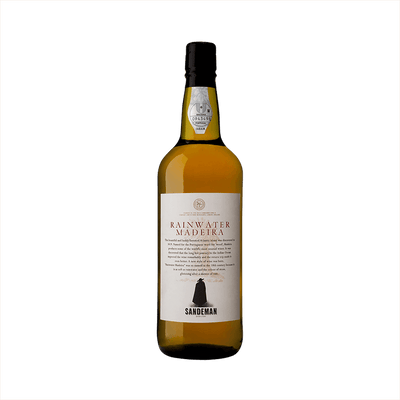Rainwater Madeira
What is Rainwater Madeira?
Rainwater Madeira is a specific style of this fortified wine from Portugal's Madeira island, traditionally made from the Tinta Negra grape variety and aged using the solera system. What defines Rainwater Madeira is its lighter, more delicate character compared to other Madeira styles—it's medium-dry with a pale golden color and subtle nutty flavors that develop through controlled oxidation and heat aging. The "Rainwater" name comes from old shipping legends about casks being diluted by rainwater during ocean voyages, though today it simply refers to this distinctively refined and accessible style of Madeira that works beautifully both as a sipping wine and in cocktails.
Learn More About Rainwater Madeira
What makes Rainwater Madeira unique?
Rainwater Madeira stands apart as the lightest and most delicate style of this fortified wine, traditionally made from Tinta Negra grapes and aged using the gentler canteiro method rather than the intense estufa heating process. Unlike the richer, more concentrated Malmsey or Bual styles, Rainwater offers a pale golden color and crisp, refreshing character with subtle nutty and citrus notes that make it surprisingly approachable for newcomers to Madeira. This style gets its poetic name from the colonial American practice of collecting rainwater in casks on ships, which supposedly diluted and softened the wine during ocean voyages, creating this uniquely mellow expression.
How is Rainwater Madeira made?
Rainwater Madeira starts with white grapes like Tinta Negra or Verdelho that are fermented and then fortified with grape spirit to stop fermentation and preserve residual sweetness. The wine undergoes the distinctive estufagem process, where it's heated in tanks or aged in warm attics called canteiros for several months to years, creating those characteristic caramelized, nutty flavors through controlled oxidation. This unique heating method, combined with the wine's exposure to air during aging, gives Rainwater Madeira its amber color and complex profile that balances sweetness with bright acidity.
How do you drink Rainwater Madeira?
Rainwater Madeira shines brightest when sipped neat at cellar temperature, allowing its complex nutty and citrusy notes to unfold naturally on your palate. While some enjoy it lightly chilled or with a splash of water, this delicate style of Madeira rarely appears in cocktails since its subtle character gets easily overshadowed by other ingredients. The wine's bright acidity and refined sweetness make it perfect as an aperitif during warmer months or as an elegant after-dinner drink when you want something lighter than the richer Malmsey or Bual styles.
How do I choose good Rainwater Madeira?
Look for producers like Blandy's, Henriques & Henriques, or Justino's who age their Rainwater for at least 3-5 years, which gives you that characteristic nutty sweetness without overwhelming intensity. For cocktails, stick with younger expressions since the subtle complexity will complement rather than compete with other ingredients—save the expensive 10-year bottles for sipping neat. The key is finding that sweet spot where you get authentic Madeira character at a price point that won't make you wince when mixing it with citrus and spirits.
Nutritional Information
Typical Calorie Range per Ounce: 35-45 calories
Typical Carbohydrate Range per Ounce: 3-5 grams
Typical Sugar Range per Ounce: 2-4 grams
Typically Gluten Free: Yes
Rainwater Madeira, like most fortified wines, is naturally gluten-free since it's made from grapes. The moderate sweetness level of this style keeps the sugar content lower than many dessert wines, while the fortification brings the alcohol content to around 19-20%. Always check the specific product label and manufacturer information to confirm gluten-free status, especially if you have celiac disease or severe gluten sensitivity, as production facilities and additives can sometimes introduce cross-contamination.
Scrolled this far? Your reward? Rainwater Madeira Trivia!
- The name has nothing to do with actual rainwater. "Rainwater" Madeira gets its name from Francis Newton Rainwater, an American merchant from Savannah, Georgia, who became so obsessed with a particular style of medium-dry Madeira in the 1800s that producers started calling it "Rainwater" in his honor. The guy literally got a wine style named after him just for being a really good customer.
- It survived the American Civil War by accident and became a legend. When Union forces blockaded Southern ports, massive stocks of Rainwater Madeira got trapped in Savannah cellars for years. The extended aging turned what was already good wine into liquid gold. Post-war tastings revealed these "forgotten" bottles had developed incredible complexity, making aged Rainwater Madeira the stuff of legend among wine collectors.
- The grapes get cooked, not just fermented. Rainwater Madeira goes through a unique heating process called "estufagem" where the wine is literally baked in heated tanks at around 140°F for months, or aged in hot attics for years. This controlled cooking process creates those distinctive caramelized, nutty flavors that make Madeira virtually indestructible – some bottles from the 1700s are still drinkable today.
- It's technically a "mistake wine" that became a masterpiece. Madeira wine was originally created by accident when Portuguese ships carrying regular wine to the New World got delayed by storms and trade winds. The constant motion, heat, and time transformed the wine into something completely different and surprisingly delicious. Winemakers eventually realized they could recreate this "shipping sickness" on land.
- Thomas Jefferson single-handedly made it America's most fashionable wine. Our third president was so crazy about Rainwater Madeira that he ordered it by the pipe (126 gallons at a time) and served it at every important state dinner. His endorsement made Rainwater Madeira the must-have drink for American high society, and it remained the country's most prestigious wine until Prohibition killed the party.
Higher-proof spirits can be intense. Mix carefully, taste thoughtfully, and enjoy responsibly.
Gift message (optional)

